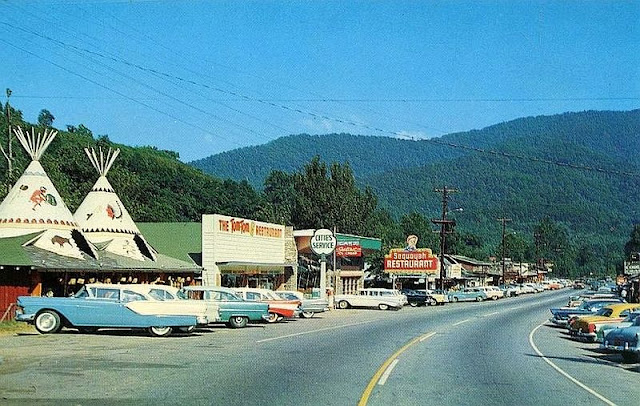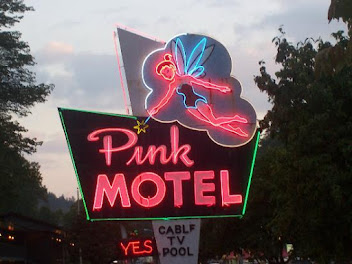 |
| Google Image Search |
(I do not own any of the images in this post.)
⛺ Tent camping
🏡 Cabins
🚌 RV camping
🚿 Showers
🚽 Bathrooms
💧 Water
⚡ Electricity
🚙 Drive up access
 |
| KOA During my rebellious youth I turned my nose up at campgrounds like KOA. I thought I was too cool to camp with bathrooms and electricity, and because I had camped there as a child, I thought it was for families and old people. Haha, now I am the old person with a family. I still like to rough it occasionally, but now I realize there is something to be said about a campground with amenities. Especially when it's in a location with loads of interesting things to do and beautiful sites to see. The town of Cherokee is part of the Qualla Boundary, a land trust owned by the Eastern Band of the Cherokee Indians in western North Carolina.The land is mountainous and densely wooded. The town sits in the Oconaluftee River Valley. Cherokee people or their ancestors have lived there for thousands of years, once controlling 40,000 square miles. The dense woodland and steep terrain in the mountains helped protect some of them from the initial invasions of Europeans. According to legend first contact occurred when an ancestral town was visited by Spanish Conquistador Hernando de Soto in 1540, it wasn’t a pleasant experience. The Cherokee were the largest tribe in the southeast at the time of English colonization. The coastal elites had no interest in pioneering the rugged mountain terrain and it wasn’t until the 1750's that poor second or third generation German and Scotch-Irish immigrants began moving to the mountains from Virginia and Pennsylvania colonies. A group of working class Scotch-Irish immigrated directly from Europe just before the Revolution. All of these pioneers were brought to the area by the cheap land as the new colonial upper class had driven up real estate prices. The Cherokee were experienced traders and had already created a thriving economy shared between the eastern tribes. They led these tribes into trade, military alliances, and real estate negotiations with the Europeans, leading to the nickname of the civilized tribes. (Clearly, it should go without saying, how terrible it is that people had to change their way of life to fit the western idea of what was considered 'civilized' when it was their civilization that had existed on the land for thousands of years prior.) The English, who were developing the Carolina colonies, notoriously cheated the tribes. Then the Cherokee lost another large portion of their land holdings after choosing the losing side in the Revolutionary War. The Cherokee adapted to their new economic reality and began to further assimilate, they created an American style government structure and colonial style homesteading. A small number of the tribe secreted themselves in the mountains and were able to avoid removal. NC conducted the country's first geological and mineralogical survey in 1839 as the first gold rush brought a new influx of commercial mining to the state. This further fueled westward expansion along with logging and the railroad. During the Civil War the Cherokee who managed to stay on ancestral land in the Great Smokies joined with Scott-Irish highlanders in an attempt to impede the Union’s progression southward. After the war large scale timber operations owned by wealthy outsiders milled wood for the state’s budding furniture industry. In the 1870's, The Eastern Band of Cherokee were able to purchase (yes, buy back a tiny percentage of their own land from the people who stole it.) about 50,000 acres of the land in the river valley, which the federal government eventually recognized as the Qualla Boundary. At the end of the rapid industrialization of the 1800's, that led to the wealth of the Gilded Age, the laissez faire attitude of the government when it came to regulations began to show its consequences, mining and lumber industries stripped much of America of its beautiful natural resources. Early environmentalists and outdoors enthusiasts took notice, and finally so did congress, who passed several acts to insure the continuous availability of natural resources. Some of the Gilded Age wealth began to trickle down as the philanthropist children of industrialists became interested in nature, or at least, their purified version of it; carefully planned, developed and preserved as parks, with public restrooms, and a modern road system complete with scenic overlooks. Edith Vanderbilt, sold 86,700 acres of their Biltmore Estate in 1914 to the government for the Pisgah National Forest, which was officially established two years later as one of the first created under the Weeks Act. Click HERE for more about the Vanderbilt's. Cherokee National Forest in east Tenn, and Nantahala National Forest in southwestern NC were established in 1920. Nantahala means land of the noonday sun in Cherokee because the forest is so dense that the sun only reaches the woodland floor at high noon. The National Park Service, created in 1916, made it publicly known that they were interested in creating a park somewhere in the eastern United States. Congress authorized the creation of the park in 1926, but there wasn’t any money allocated to the project. Philanthropist heir to the Standard Oil fortune, John D. Rockefeller, Jr. gave $5 million. The government was convinced to put up $2 million. Investors from NC and TN began purchasing land and evicting the remaining timber and mining operations. This displaced families who were living in the small communities run by these companies. Many of the native families moved to Cherokee land. During the Great Depression, the CCC, the WPA and other New Deal organizations built the park's infrastructure and gave jobs to those left behind by the removal of industry. Some Cherokee opened boarding houses for the workers. In 1940 it was finally officially chartered as a National Park. This began a new chapter for the Eastern Band Cherokee; the creation of an economy totally reliant on tourism. Not just ecotourism, Americans were traveling to the park for the beauty of the mountains, but they were also drawn by their curiosity and romanticism of Native culture. Families displaced or jobless from the creation of the park began to cater to the tourists. Those who had run boarding houses opened inns, or rented small cabins along the river. The post WWII era in America gave way to a pop culture explosion. Hollywood loved the story of the ‘cowboys and indians’. Cherokee became a mecca for kitschy roadside stops, drawing in crowds of tourists with flashy neon signs, giant sculptures, and tee-pees, (the Cherokee built log homes, not tee-pees). There is a 25 foot tall shirtless Indian (Currently in storage pending relocation, stay tuned for an update on him.) The old inns were advertised with rustic frontier style signage, or cartoon symbols associated with Native American people. The new motels had modern neon signs and swimming pools. Gift shops and animal attractions had billboards and totem poles, (the Cherokee did not historically have totem poles). That’s the Cherokee that I vividly remember from my childhood. A place with a surreal quality to it that at the time I didn't understand. Philosopher Jean Baudrillard would have said it was an example of the hyper real, the real was replaced by reproductions that were disconnected from the reality of the original thing. The age of industrial expansion in America created a commercialized version of reality where everything became like Disneyland. (Click HERE for my post explaining Disneyfication.) “Chief Henry”, ‘the most photographed Indian in the world’ greeted tourists at the strip of souvenir shops for 60 years. He sold his image, families would line up to pay to have their pictures taken with him bare chested wearing a headdress. He died of lung cancer in his 70's. I remember the street corner chiefs. For a dollar they'd pose for a picture with you. I also remember squealing with delight as I put quarters into the animal arcades to watch chickens, ducks, and rabbits perform tricks like dancing or playing tiny instruments. I got in trouble once when I was very young because I got away from my parents inside the souvenir shop and ended up walking out to the bear attraction. They found me there, staring down at a sad skinny bear in a concrete pit resembling a small swimming pool. Cherokee had three bear attractions back then, all of which have come under scrutiny from animal activists and pressure from tribal leaders. Although the animal attractions may no longer be a tourist draw, some of the original roadside sites are still around. It is truly an Instaworthy town. There are still countless atomic era motel signs. One of my strangest memories of Cherokee in the 1980's was lit by the neon of one of these signs. We were camping in a tent by a river in the KOA campground with mom, her best friend and her son. The first night it was very cold, throughout the next day it got even colder. As the sun began to set beyond the mountains it started snowing. The moms broke down the tent while the kids sat in the running car. We drove to the nearest motel. It was pink. Heck it was literally called the Pink Motel. It was not in the best shape, everything was from the sixties. But the sign had Tinker Bell on it and it had heat. There was a color tv. An earthquake had hit California and Johnny Carson wasn’t on. Instead it was terrifying images kids our age probably shouldn’t have been watching. The moms turned it off. Pink neon from the sign lit the room all night and I couldn't sleep. I stared at the popcorn ceiling, the shag carpet, and the pink door with all it’s locks. It was scarred, like someone had repeatedly thrown their knife into it. The Pink Motel is still there and has been updated. The sign is a popular stop for photography. Everyone jokes about the myths of Indian Princesses, but The Pink Motel was built by an Indian Queen. Lois Queen Farthing was born to an English father and a Cherokee mother who had cabin rentals for tourists after being displaced by the park. Her Cherokee grandparents had run a boarding house for the CCC. They raised her to be a strong independent business woman who first opened a hotel with a restaurant and gift shop at the age of 23. When she opened the Pink Motel her daughter wanted Tinker Bell on the sign, and it became a landmark. She was very civic minded and became integral in bringing the Unto These Hills performance to the area, the outdoor drama about Cherokee history which has now been seen by over six million people. There are plenty of camping options and loads of motels in the Cherokee area, but I definitely want to plan another trip to the KOA. They have river side sites with electricity and water hookups. Tent campers and all sizes of RVs welcome. Next time I'm going when there is no chance of snow! |





















No comments:
Post a Comment